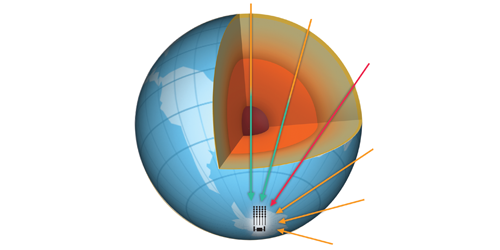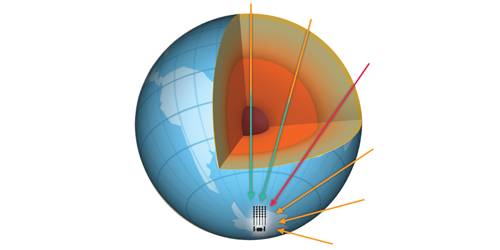Putting Neutrino Oscillations on Ice
Atmospheric neutrinos—created when cosmic rays collide with molecules in the upper atmosphere—can oscillate from one flavor to another as they travel to detectors on the ground. The IceCube Neutrino Observatory located at the South Pole has measured the oscillation of atmospheric neutrinos in an energy range that is a factor of 10 higher than previous experiments. The results reduce the uncertainty on certain oscillation parameters, helping to resolve a tension in recent measurements.
Experiments that observe atmospheric neutrinos record not only the neutrinos that are created 10 km overhead and rain down into the detector but also those that pass some 10,000 km through the Earth and appear moving upward inside the detector. Earlier studies, looking at neutrino energies around 1 GeV, identified a deficit of upward-going muon neutrinos. The favored explanation is that as they pass through Earth, the muon neutrinos oscillate into tau neutrinos with a large “mixing” amplitude. However, recent experiments using neutrino beams from accelerators have disagreed over the value of the muon-tau mixing amplitude.
The IceCube experiment—an array of over 5000 photodetectors in a cubic kilometer of Antarctic ice—can target higher-energy neutrinos than smaller water-based detectors. Collisions between these neutrinos and nucleons in the ice can create particle cascades that produce a detectable Cherenkov-light signal in the detector’s large volume. The IceCube Collaboration has now analyzed data from 2012 to 2015, identifying atmospheric neutrinos in the 5 to 50 GeV range. Their observations of muon neutrino disappearance put new constraints on some of the relevant oscillation parameters. In particular, the results agree with those experiments indicating that the mixing amplitude between muon and tau neutrinos is close to the maximum value allowed by theory.
This research is published in Physical Review Letters.
–Michael Schirber
Michael Schirber is a Corresponding Editor for Physics based in Lyon, France.





